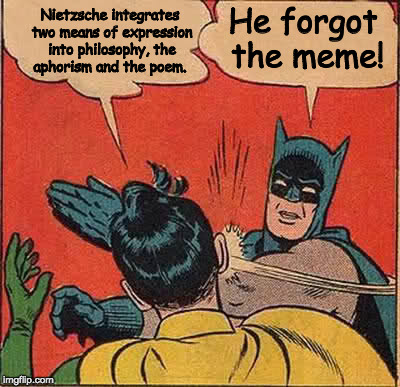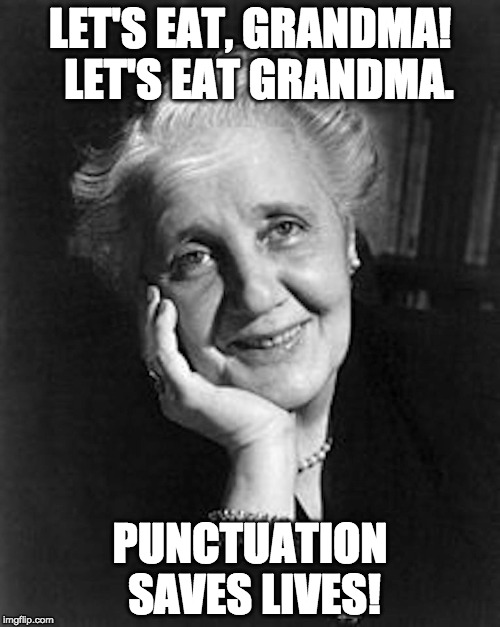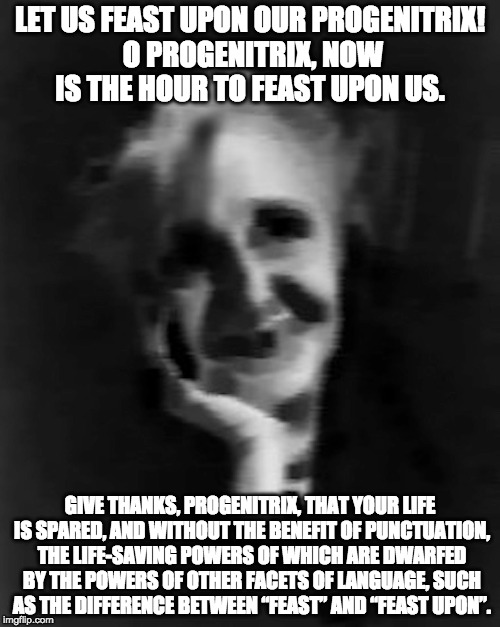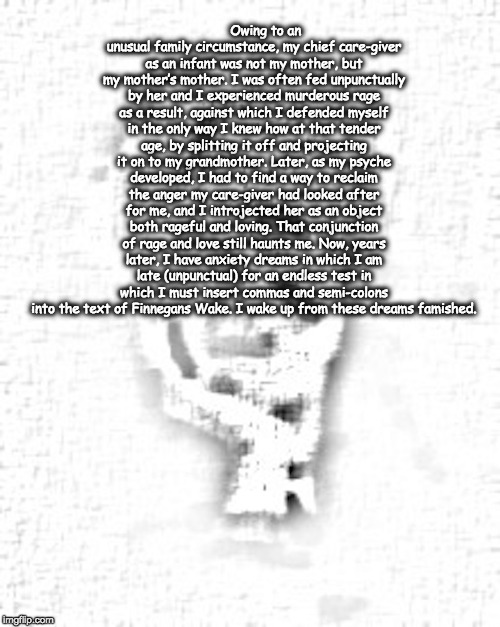I wrote this piece for a literary magazine that wanted “objects + meaning.” I thought this fit the bill pretty well but they rejected it. So here it is anyway!
Batman, Robin, and Me
Simon J. Evnine
Memes are among the most ephemeral of contemporary cultural artifacts. Yet one of them, the image of Batman slapping Robin, has been an unexpected catalyst of personal and professional growth for me for about five years now.

In Spring 2016 I started making memes with this image and posting them on Facebook, at first just two of them and then, after a month of dormancy, a torrent of over 100. For reasons which were initially obscure to me, I had always gotten a great kick out of memes that used this image. I would experience a little jolt of pleasure every time I saw one. The realization that I could make them myself, and the ensuing creative activity, unlocked doors in my unconscious that I hadn’t even realized were there. As I posted increasingly esoteric memes of Batman slapping Robin on Facebook I came to think of them as constituting what I called The Batman Meme Project. The idea took hold of me that when I had gotten whatever it was that was driving me out of my system, I would gather them together and provide explanations of the things I uncompromisingly refused to explain while I was posting them. Unattributed allusions to the Talmud, Virgilius Maro Grammaticus, Lope de Vega, Thomas Browne, Sigmund Freud, A.E. Housman, Dodie Smith, and John Cage (among others), untranslated bits of Latin, Armenian, and Yiddish, would all be clarified and explained. Thus began my work on A Certain Gesture: Evnine’s Batman Meme Project and Its Parerga!. It’s been five years and I’m not even halfway through my commentaries on the memes. Meanwhile, the ambitions of the work have grown enormously, to the point where I am now thinking of it as a new way of doing philosophy, one that incorporates self-writing, humor, and indirection.
What is it about the image of Batman slapping Robin that so affects me? In its original comic book context, the orientation of the panel has Batman on the left but its life as a meme began with a reflected version that puts Batman on the right, responding to Robin rather than initiating the interaction. It depicts a grown man striking a young boy; a man who faces us but from behind a mask, striking a boy whose face we cannot see; a slap to a bare cheek delivered by a heavily gloved hand. It speaks through the cartoon speech bubbles, but what it says must be supplied anew each time it is used. The sound of slap is indicated visually by lines tracing the movement of the hand and the shockwaves it causes. The image is specular. It is simultaneously silent and deafening.
My obsession with the image began when I was already three years into my psychoanalysis but despite its late arrival, it came to be a fundamental point of reference for my analyst and me – a malleable and suggestive metaphor for a welter of psychic processes. It soon became apparent that for me the image played out an intrapsychic conflict in which I identified with both Batman and Robin. My pleasure in the represented scene was both masochistic and sadistic. I hated the precocious and eager child I had been, the child who was still within me and whom I wanted to obliterate. At the same time, I wished that I had been taught “not to make a fool of myself,” that someone had thought to give me a good slap. I wanted discipline, rigor, and control, and I wanted to discipline, rigidify, and control parts of myself that defied and threatened my adult defenses.
In fact, I have a history with Batman and Robin. Here I am at about six or seven years old, playing Robin in a home movie made by my then-16-year-old brother with a few of his friends.

That Batman mask and the barely visible cape and vambraces being worn by my brother’s friend were mine, a birthday gift because I so loved the live-action Batman TV series that was airing around that time. Yet here I am, ‘demoted’ to playing Robin! And as if that in itself were not bad enough, the ‘plot’ required me to crawl away on all fours and pee like a dog.

And was that spot on my underwear there naturally, dirty little boy that I was? Or was it placed there by the director, my much-loved older brother, for comedic effect? Was I being betrayed humiliating myself? Was my eagerness to participate being exploited?
That live-action Batman series was also the site of premature sexual knowledge. I might have seen nothing suspicious in those shots of the Dynamic Duo climbing up a wall, Robin first, then Batman, their bodies locked together in a single crouch. But my two much older brothers and my father certainly understood their significance and so I learned it as well. It was in connection with the series that I learned, from my father, the word “catamite” and he would also refer to Robin as “Batman’s little buggery boy.”

No wonder, then, that shame over my childish self, my adult desire to punish his weakness and childishness, and my childish desire to have been ‘put in my place,’ should coalesce around the image in the meme. How could I not have been gripped by it?
As work at my desk and on the couch have both progressed, in tandem, some of that ferocious self-contempt has abated. That means I find myself increasingly able to play, to be spontaneous and joyful. My book is not only tied to my analysis, though, it is part of my professional output. Philosophy as a discipline, in the Anglophone world, is dominated by rigor, clarity, precision, all the weapons of control and sadism. My book is part of an attempt to free myself from that. It approaches philosophy in a personal and ludic spirit. It is a kind of philosophical free association. The goal of inserting oneself into academic work is something is shares with (indeed, derives from) work by feminist theoreticians. But unlike the brave people who have truly put their lives on the line, it is hard for me, a person of privilege, to justify to myself and others the throwing over of the academic norms of privilege.

The very first time I gave a presentation on my book-in-progress in an academic setting, I remember worrying about this and, in thrashing it out in my mind, I came up with two contradictory ways of conceptualizing the presence of myself in my work. Rather than choose between them, I read the two opposing introductory paragraphs (along with a further two) at the talk. Here is one:
Many people have a strong desire to speak, or more pertinently, to write about themselves… What I am talking about is a strong, almost primordial desire, stemming from our earliest years, for visibility – a desire to be seen and known. To be counted. But a desire to be seen depends on others to see us. One must fight for the attention of, and recognition by, others who may have no interest in seeing or counting one. For those, then, who seek to gratify this desire to be seen through self-writing, various strategies present themselves. Humor is one obvious way to mediate one’s desire for recognition – the child learns not to scream, but to caper! Lyricism is another. More complex strategies are also available. The general can be coaxed from the particular details of a life so that in reading about the other, the reader can also read about herself. And, where the events and idiosyncracies of a person’s life are of a kind that are theorized about in some on-going discursive practice, some variety of theory, the possibility arises of intertwining the expression of the desire for visibility with the pursuit of that discursive practice.
Whatever form the accommodation takes, it is a compromise between the childish desire to be seen and the adult realization that being seen requires an other to do the seeing and that such seeing is not simply there for the taking. The childish desire to show one’s face is met, as it were, with a slap by the reality principle that knows that to be seen, a face must mask itself in some way to make it enticing to the viewer. The upwelling or over-flowing needs of the id must be tamped down by the ego and super-ego.

That is what I see in this image. An enthusiastic, youthful Robin, as yet unsuccessful in making himself visible to us, is schooled by the older Batman. “No-one is interested in you, Robin,” the image itself seems to say. “Your childish capers are insufficient excuse to speak. Wear a mask!”
My book is a project conducted under the dubious sign of this equivocal image. But the mask I shall wear, the theoretical discourse by means of which events and idiosyncracies of my life will gain expression, will be the dry and dusty discourse of analytic philosophy. You may imagine, if you choose, what expressions and what distortions of my self this will allow and entail.
In this introduction, I am the little boy, desperate for attention, sneaking my person into philosophy that, for others, helps the medicine go down. This little boy needs to be stopped from making a fool of himself, needs to be taught his insignificance. Here is the other introduction:
In 1969, the expression “the personal is political” was coined by feminist thinkers to challenge the idea that there is a disjuncture between the personal and the broader structures of power in which individuals are inscribed. If we interpret “political” broadly, so as to include all forms of public, institutional discourse, a special case of the expression would be “the personal is philosophical.” This special case would cover efforts to overcome the disjuncture between the personal and the conventions and norms of philosophy as a discipline. Those norms enjoin authors to keep their own personalities out of their work, enjoin readers to focus only on the ‘ideas’ in the text, ideas that are supposed to be able to circulate without any vital connection to the lives and circumstances of their authors. This valorization of objectivity and impersonality, with its effacement of the people who produce philosophy and the ways their individuality affects the contents of their philosophy, has left philosophy shriveled and immature, deprived of the nourishing life-blood of the real people who make it. What is desperately needed for the reinvigoration of philosophy is the rude and forceful interpellation of our stunted disciplinary norms by the subject, in all her strange specificity and individuality. Auto-theory is one form this interpellation can take: the calling out of a moribund modality of philosophy by the subject, slowly and seductively revealing her own face. But because each subject is singular, unique, and real, the face of her desire, even as it reveals itself, will always retain an element of inscrutability to the other. “Fetish” is the name we give to what is inexplicable, what is surd, in desire.

My project is a work of auto-theory, conducted under the sign of this image in which the joyful, liberating, fetish-clad warrior, in his idiosyncratic singularity, forces the intrusion of the personal onto the stunted, childish discipline of academic philosophy, trying, with a slap, to bring the blood to its face, trying to rouse it from its valorization, at once perverse and torpid, of the production of philosophy without a visible human face.
For me, the image of Batman slapping Robin is about the relation of adult to child, of work to play, of the settled ways of doing things and the playful impetus to experiment, of id and superego. Working with it, and on it, has been integral both to my analysis and to my philosophical development. It has allowed me to make peace with my childish self. I hope that, at some point in the not too distant future, it will help me erase the distinction altogether between adult and child.
















